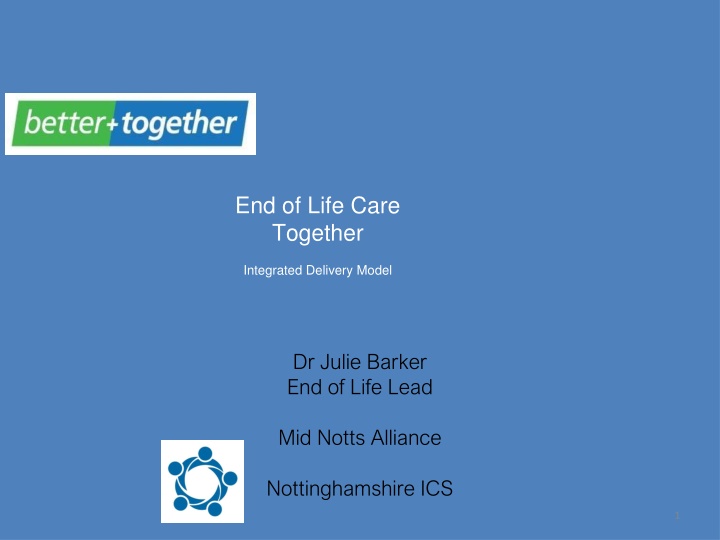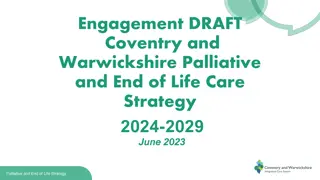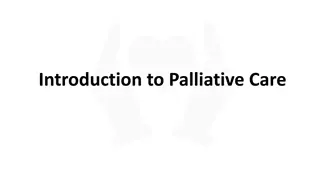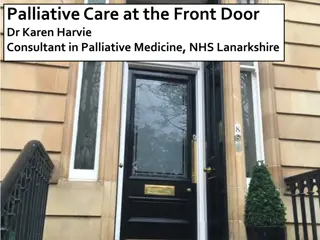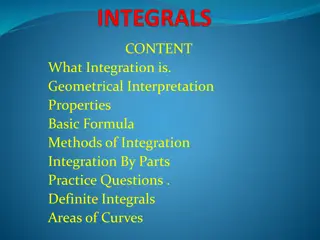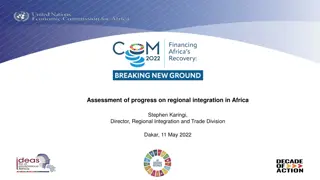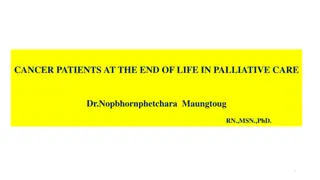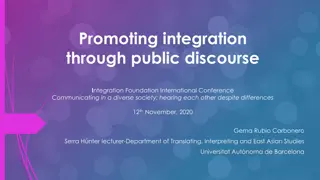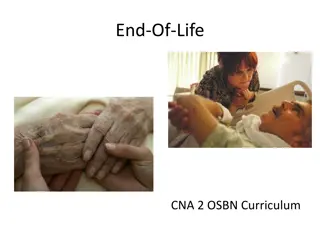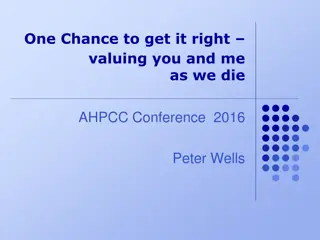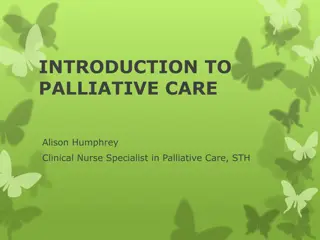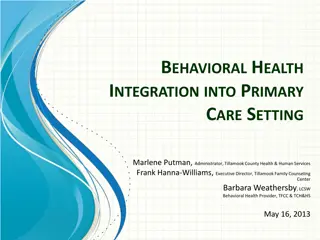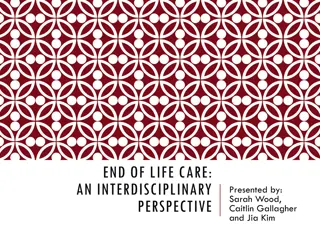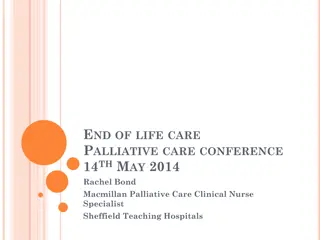Innovative End-of-Life Care Integration Model by Dr. Julie Barker
"Dr. Julie Barker leads an integrated end-of-life care model in Mid-Notts Alliance, focusing on collaboration with various stakeholders to enhance patient care. Key performance indicators are outlined to measure quality, including patient identification strategies, advance care planning, and reducing unnecessary hospital visits. The model aims to increase patients dying in their preferred place, improve advance care planning rates, and minimize emergency department visits, ultimately striving to provide compassionate and effective end-of-life care."
Download Presentation

Please find below an Image/Link to download the presentation.
The content on the website is provided AS IS for your information and personal use only. It may not be sold, licensed, or shared on other websites without obtaining consent from the author.If you encounter any issues during the download, it is possible that the publisher has removed the file from their server.
You are allowed to download the files provided on this website for personal or commercial use, subject to the condition that they are used lawfully. All files are the property of their respective owners.
The content on the website is provided AS IS for your information and personal use only. It may not be sold, licensed, or shared on other websites without obtaining consent from the author.
E N D
Presentation Transcript
End of Life Care Together Integrated Delivery Model Dr Julie Barker End of Life Lead Mid Notts Alliance Nottinghamshire ICS 1
Ambulance EMAS Compassionate Community Churches etc Hospices x3 Respec t EPaCCS 370 Care homes OOH/11 1 NEMS Care Patient Indentification Strategy Co-ordination Service
Key Performance Indicators Measuring Quality Please note the KPI s are to be finalised to ensure the most effective measures are included in the model Current service provision Non-dependent KPI s across 5 contracts KPI s Do not reflect the whole patient pathway acute care, social care, third sector, making baseline data analysis redundant No coordination of KPI s leading to possible duplication of service Currently 27% of patient in the last year of life will present at ED Currently 0.4% of the total population is registered on EPaCCS 1111 Patients in Mid-Notts died in an acute setting which is 66% of all deaths. Proposed KPI s central data source from EPaCCS KPI Threshold % of deaths in preferred place of care A 5% annual increase in the number of end of life care patients that die in their place of choice or usual place of residence (Year 1) Number of patients with written advance care plan or evidence that an advance care plan discussion has been offered Year one establish a baseline for all patients with an advance care plan Annual % increase until 90% of all patients on the end of life care register have been offered an advance care plan 0.7% of all patients in year one and continue to maintain Increase number of patients identified on EPaCCS Patient Identification Reduction of unnecessary ED attendances to hospital for patients at End of Life Additional PROMS evaluations will be undertaken to improve quality to include: Year one establish a baseline followed by an agreed annual % increase ReSPECT, Patient and Public inclusivity and equity, bereavement support and patient quality 3
Compliance with KPIs Key Performance Indicator % EOL patients attending ED (M&A) Oct 18 - Sept 19 6.0 4.5 3.0 1.5 0.0 Oct-22 Dec-22 Feb-23 Apr-23 Jun-23 Aug-23 % EPaCCS pts attending ED Plan Key Performance Indicator % EOL patients attending ED (N&S) Oct 18 - Sept 19 8.0 6.0 4.0 2.0 0.0 Oct-22 Dec-22 Feb-23 Apr-23 Jun-23 Aug-23 %+KPI!$1:$1 of EPaCCS pts attending ED Plan 4
Key Performance Indicators Increase of patients registered on EPaCCS: 2127 patients are registered on EPaCCS Increase in the number of patients with an Advance Care Plan: of the 2127 patients on EPaCCS 1208 have an advance care plan Increase in the number of patients who achieve their preferred place of death: Patients with preferred place of care recorded 82% of patients achieved their preferred place of care Reduction in the number of deaths within four days of admission: Reduction in ED attendances: 585 less attendances from October 2018 to April 2019, compared to compared to baseline period Reduction in Hospital Admission following ED attendance: 288 less admissions from October 2018 to April 2019 compared to baseline period 5
Summary of Notts ICS EOL Workstream Enablers and interdependencies Workforce: recruit, inspire, retain resilient skilled professionals. Themes and activities in WORKSTREAM (Priorities) 1 1 Implement an identification strategy targeting commonly missed groups (e.g. learning disabilities, dementia, non-malignant long term conditions) and incorporating all relevant organisations including care homes and community groups Gold Standards Prognostic Indicator Guidance Initiatives to promote public discussion of dying, death and bereavement to empower the public to identify their own needs and those of each other. e.g. Dying matters week, Death Cafes etc. https://www.dyingmatters.org/ Identification of patients likely to be in their last 12 months of life 2 IM&T: Ongoing resources required and analysis of data available to feedback activity to organisations on a local level All patients have the opportunity to complete an advance care plan (ACP) http://endoflifecareambitions.org.uk/ a)Dementia patients should be supported to start an ACP within a year of diagnosis b)Those with learning disabilities should be supported to make detailed advance care plans which may require best interest decisions multidisciplinary meetings to ensure full MCA compliance 3 2 Care of the Patient Personalised care plan Holistic Symptom control Communication Care co-ordination Roll out the ReSPECT process www.respectprocess.org.uk/ A robust sustainable long term strategy for developing IT to facilitate sharing of plans. All organisations should be able to access the most recent version of the plan when they need to. Individuals should have easy access to their own plans. http://endoflifecareambitions.org.uk/ http://www.endoflifecare- intelligence.org.uk/view?rid=787 Develop a care co-ordination service, directly accessible by patients, carer and professionals. Accessible to all identified patients 24/7. This should reduce inappropriate interventions and release resources to increase capacity http://endoflifecareambitions.org.uk Estates: 4 Mental health: long waits for psychological support, poor access for those who are housebound. 5 6 Prevention: Strategy to improve pain control in the home. All patients should have prompt access to measures to effectively control pain and distressing symptoms. Hospice UK No Painful Compromise https://www.nice.org.uk/guidance/ng31 Specialist palliative care should be available 24/7 for those with more complex needs. 7 Organisations Out of Hours 111 EMAS Social Care 3rdSector Services Integrated, collaborative relationships required Community partnerships Patient groups Faith/cultural groups Develop a framework for education, training and continuing professional development http://endoflifecareambitions.org.uk http://www.goldstandardsframework.org.uk/training-programmes End of Life Care educational support to primary care, secondary care and community health care teams 8 3 Support those important to the dying person Regular support Respite Bereavement Care 9 Identify carers and undertake a carer s care plan to ensure their needs are met http://www.ncpc.org.uk/sites/default/files/Who_Cares_Conference_Report.pdf Increase capacity for care at times and in places that are currently under-capacity. To ensure black and minority ethnic communities, those in deprived areas, the homeless and imprisoned have equal access to care. http://endoflifecareambitions.org.uk Enable integrated working via suitable contract that mandate this 10 11 Ensure carers are aware of how to access psychological support (pre-bereavement and bereavement care). Develop a Listening Service within practices to increase front line access 12 Commission resources/services to promote patient and carer self care Each community is prepared to help All staff are prepared to care Maximising comfort and wellbeing Each person is seen as an individual Each person gets fair access to care Care is coordinated
In Progress Develop PROMs e.g. IPOS across all providers Case finding via care navigators - LTC data workflows with EOL workflows Roll out Care co-ordination across ICS Consider Notts combined contract (big ask) or Greater Notts combined contract (slightly easier?) Continue Respect process rollout QOF EOL QI local guidance and collation & support of practice plans Enhanced Care in Care Homes Implementation to link with EOL training + stronger links to primary care Developed resources for networks - including shared details of silver & gold accreditation Use the Patient ID strategy across all organisations Incorporate Fast track CHC resources into envelope and consider linking to quality markers.
End of Life Care Together - Part of STP/ICS EOL work stream one of 5 in STP (key element of urgent care) 2 delivery units (Mid Notts & Greater Notts) Chair is both a GP and County Counsellor so brings together health and social care at a strategic level. Opportunities to identify infrastructure resources e.g. training, IT/EPaCCS Patient identification strategy or julie.barker7@nhs.net Changing culture to population wide strategy and integration.
